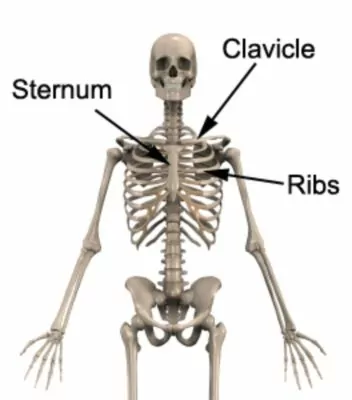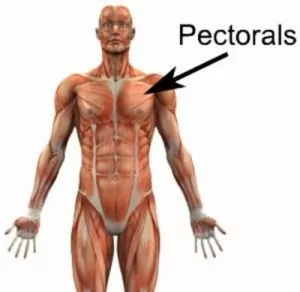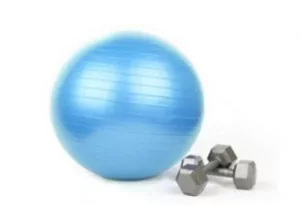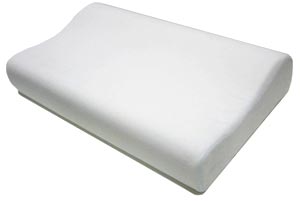Sternal Fracture
Updated:
(Also known as a Fractured Sternum, Sternum Fracture, Broken Sternum)
What is a sternal fracture?
A sternal fracture is a relatively uncommon condition characterized by a break in the sternum bone (breast bone) situated at the front of the chest (figure 1).

The chest comprises of 12 rib bones on each side of the body in addition to the sternum (breast bone) forming the front wall of the chest. The sternum provides the attachment point for the 2 clavicles (collar bones) and the upper 7 ribs on either side of the chest (figure 1). The large pectoral (chest) muscles (pectoralis major) also attaches to the sternum on each side of the body (figure 2).

Following a direct blow to the chest, stress is placed on the sternum bone, which may cause injury. This can result in a bruised sternum, or, if the impact is traumatic and beyond what the bone can withstand, a break in the sternum may occur. When the latter occurs, the condition is known as a sternal fracture.
Due to the large forces required to break the sternum bone, a sternal fracture may be associated with damage to other structures and organs of the body such as the ribs, vertebrae, heart, lungs, soft tissue and local blood vessels. These injuries (particularly to the heart and lungs) may be very serious and are more common if the fracture is severe and / or displaced.
Cause of a sternal fracture
A sternal fracture usually occurs following a traumatic, direct blow to the chest from an object or person. This most commonly occurs due to a motor vehicle accident whereby the moving chest strikes the steering wheel or seat belt. Sternal fractures also commonly occur due to cardiothoracic surgical procedures. Occasionally they may occur due to a traumatic forward bending (flexion) force to the upper back (often associated with a motor vehicle accident in the absence of a direct impact to the sternum) or due to a collision with another player during contact sports, such as football or rugby, or, from an impact from a ball in sports such as hockey or cricket.
Signs and symptoms of a sternal fracture
Patients with a sternal fracture typically experience a sudden onset of chest pain at the time of injury. Pain is often sharp and intense and may increase during deep breathing, coughing, laughing or sneezing. Patients may also experience an ache in the front of the chest that is particularly prominent at night or first thing in the morning (particularly in the first few days following injury). Pain may increase when lying down in certain positions (such as face down or on your side) and on firmly touching the sternum at the site of injury. Swelling and / or bruising may also be evident.
In severe sternal fractures with bony displacement, an obvious deformity may be present. Patients with this condition may also experience pain with certain movements of the upper back and chest (such as twisting, bending forwards or sideways, or arching backwards) and with certain movements of the upper limb (such as pushing, pulling, heavy lifting, reaching out, use of the arms in front of or across the body or with overhead activities).
Diagnosis of a sternal fracture
A thorough subjective and objective examination from a physiotherapist or doctor is important to assist with diagnosis of a sternal fracture. An X-ray is required to confirm diagnosis. Clinical examination can also determine the likelihood of associated damage to other organs such as the lungs (e.g. a pneumothorax) or heart. Other investigations, such as an MRI or CT scan, may also be performed to confirm diagnosis, assess the severity of injury and involvement of other structures. Other tests may also be used to assess heart and lung function.
Treatment for a sternal fracture

Members Only ContentBecome a PhysioAdvisor Member to gain full access to this exclusive content. For more details see Become a Member. Already a member? Login Now
Prognosis of a sternal fracture
Patients with an isolated sternal fracture in the absence of damage to other structures or organs of the body usually make a full recovery with appropriate management. Return to activity or sport can usually occur in a number of weeks to a few months although care must be taken when returning to contact sports as the sternum is unlikely to regain full strength for many months (typically 1 – 2 years). Patients with more severe sternal fractures, particularly those which require surgical correction, or when other structures have been involved, will usually require a prolonged period of management over many months before a full recovery can take place.
Physiotherapy for a sternal fracture

Members Only ContentBecome a PhysioAdvisor Member to gain full access to this exclusive content. For more details see Become a Member. Already a member? Login Now
Other intervention for a sternal fracture
Despite appropriate management, some patients with a fractured sternum do not improve adequately and may require other intervention to ensure an optimal outcome. The treating physiotherapist or doctor can advise on the best course of management when this is the case. This may include further investigations such as X-rays, CT scan or MRI, extended periods of rest, pharmaceutical intervention, bone grafts to aid fracture healing or referral to appropriate medical authorities who can advise on any intervention that may be appropriate to improve the condition. In rare cases, some patients who were initially managed conservatively may require surgical intervention (usually comprising of internal fixation of the fracture) to ensure an optimal outcome.
Exercises for a sternal fracture
The following exercises are commonly prescribed to patients with a fractured sternum. You should discuss the suitability of these exercises with your physiotherapist prior to beginning them. They should only be performed once the physiotherapist has indicated it is safe to do so and only provided they do not cause or increase symptoms.
Your physiotherapist can advise when it is appropriate to begin the initial exercises and eventually progress to the intermediate and advanced exercises. As a general rule, addition of exercises or progression to more advanced exercises should take place provided there is no increase in symptoms.
Initial Exercises
These initial exercises should generally be performed 3 times daily once the physiotherapist has indicated it is safe to do so and only provided they do not cause or increase symptoms.
Shoulder Blade Squeezes
Begin sitting or standing tall with your back and neck straight (figure 3). Squeeze your shoulder blades together as far as you can go without pain and provided you feel no more than a mild to moderate stretch. Hold for 1-2 seconds and repeat 10 times provided there is no increase in symptoms.

Deep Breathing
Begin sitting or standing tall with your back and neck straight (figure 4). Breathe in as deeply as possible without increasing symptoms and then relax. Focus on breathing with your lower lungs (instead of elevating your shoulders), allowing your lower ribs to gently expand. Repeat 5 times.

Rotation in Sitting
Begin sitting tall, with your arms across your chest. Keeping your legs still, gently rotate to one side as far as you can go without pain and provided you feel no more than a mild to moderate stretch (figure 5). Repeat 10 times to each side, alternating sides, provided the exercise is pain free.

Intermediate Exercises

Members Only ContentBecome a PhysioAdvisor Member to gain full access to this exclusive content. For more details see Become a Member. Already a member? Login Now
Advanced Exercises

Members Only ContentBecome a PhysioAdvisor Member to gain full access to this exclusive content. For more details see Become a Member. Already a member? Login Now
Other Exercises

Members Only ContentBecome a PhysioAdvisor Member to gain full access to this exclusive content. For more details see Become a Member. Already a member? Login Now
Rehabilitation Protocol for a sternal fracture

Members Only ContentBecome a PhysioAdvisor Member to gain full access to this exclusive content. For more details see Become a Member. Already a member? Login Now
 Find a Physio for a sternal fracture
Find a Physio for a sternal fracture
Find a physiotherapist in your local area who can treat patients with a fractured sternum.
 Physiotherapy products for a sternal fracture
Physiotherapy products for a sternal fracture
Occasionally, physiotherapists may recommend products to patients with a sternal fracture to ensure an optimal outcome. These products may include:
-
 Wheat Bags
Wheat Bags -
 OPPO – Posture Aid / Clavicle Brace (OPP2075)
OPPO – Posture Aid / Clavicle Brace (OPP2075) -
 AllCare Band
AllCare Band -
 Fitness Ball Pro – Loumet
Fitness Ball Pro – Loumet -
 Premium Strapping Tape 38mm (Victor)
Premium Strapping Tape 38mm (Victor) -
 AllCare Pro-TENS Machine
AllCare Pro-TENS Machine -
 AllCare Tubing
AllCare Tubing -
 Fixomull Stretch 5cm x 10m
Fixomull Stretch 5cm x 10m -
 AllCare Instant Cold Pack (15 x 25cm)
AllCare Instant Cold Pack (15 x 25cm) -
 AllCare Foam Roller Round
AllCare Foam Roller Round -
 Dentons Impressions Classic Memory Foam Therapeutic Pillow
Dentons Impressions Classic Memory Foam Therapeutic Pillow
To purchase physiotherapy products for a fractured sternum click on one of the above links or visit the PhysioAdvisor Shop.
 More Exercises
More Exercises
- Upper Back Stretches.
- Shoulder Stretches
- Upper Back Strengthening Exercises.
- Arm Strengthening Exercises
- Core Exercises.
- Scapular Stability Exercises.
- Pilates Exercises.
 More Information
More Information
- Posture.
- Postural Taping.
- Ice or Heat?
- The R.I.C.E. Regime.
- Ergonomic Desk Setup
- Safe Lifting
- Warming Up and Cooling Down.
- Returning to Sport.
- Returning to Running.
- Understanding Pain.
- Why is my injury not Improving?
- View our Upper Back & Chest Diagnosis Guide.
Become a PhysioAdvisor Member

Link to this Page
If you would like to link to this article on your website, simply copy the code below and add it to your page:
<a href="https://physioadvisor.com.au/injuries/upper-back-chest/sternal-fracture”>Sternal Fracture – PhysioAdvisor.com</a><br/>PhysioAdvisor offers detailed physiotherapy information on a sternal fracture including: causes, symptoms, diagnosis, treatment, exercises and more...
Return to the top of Sternal Fracture.

